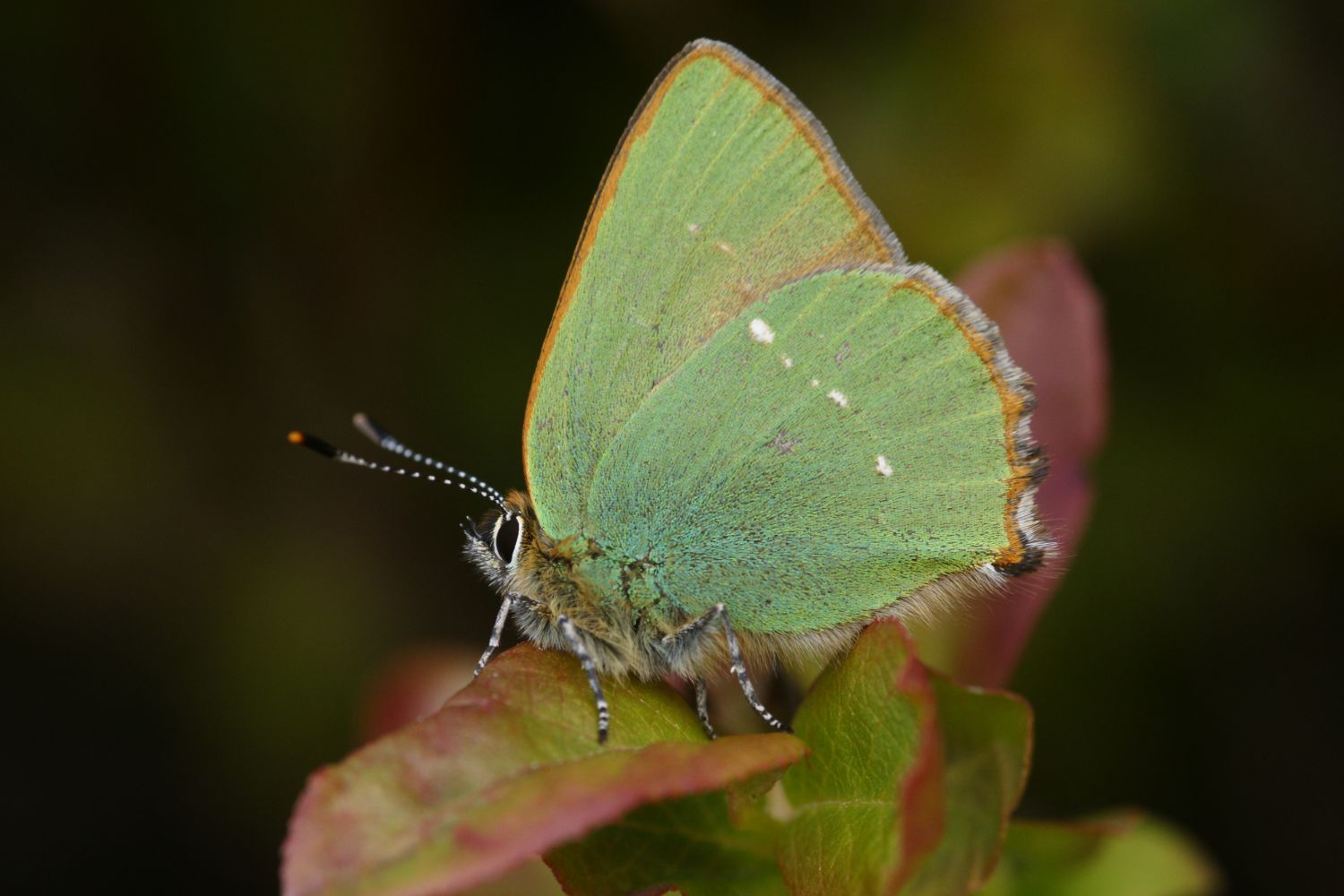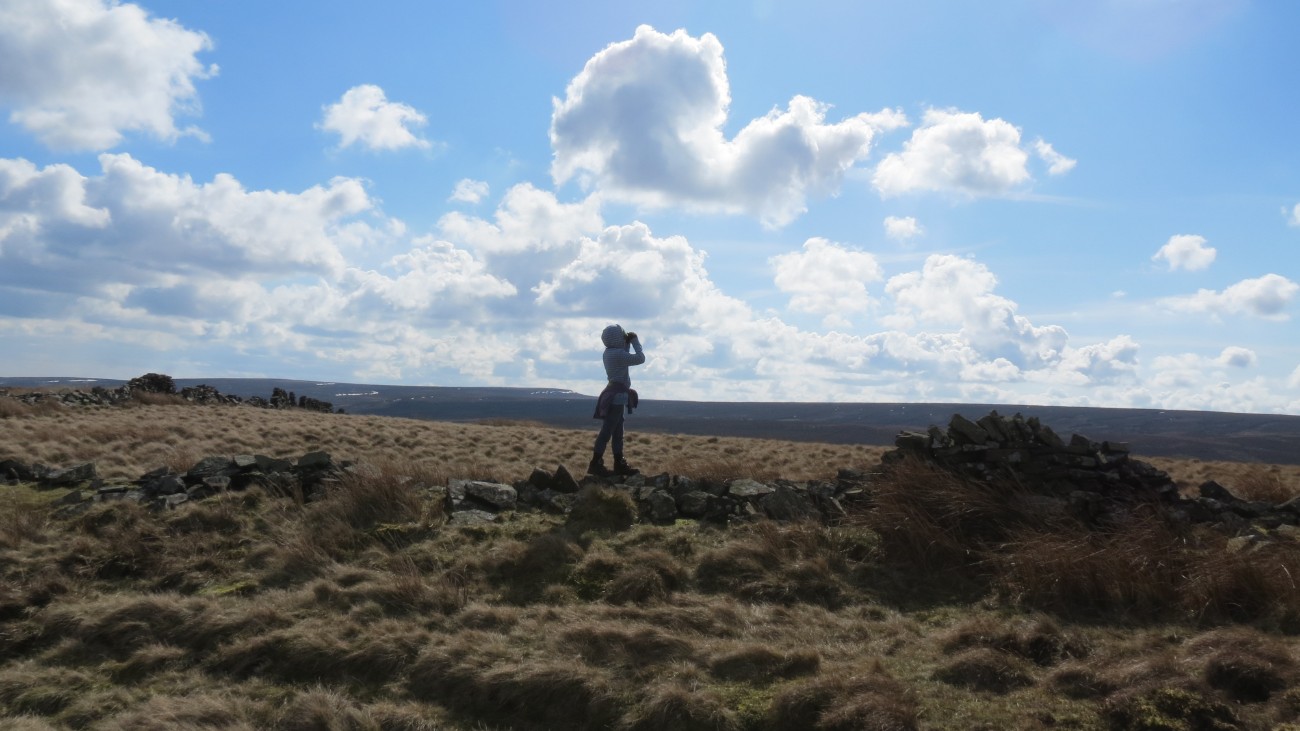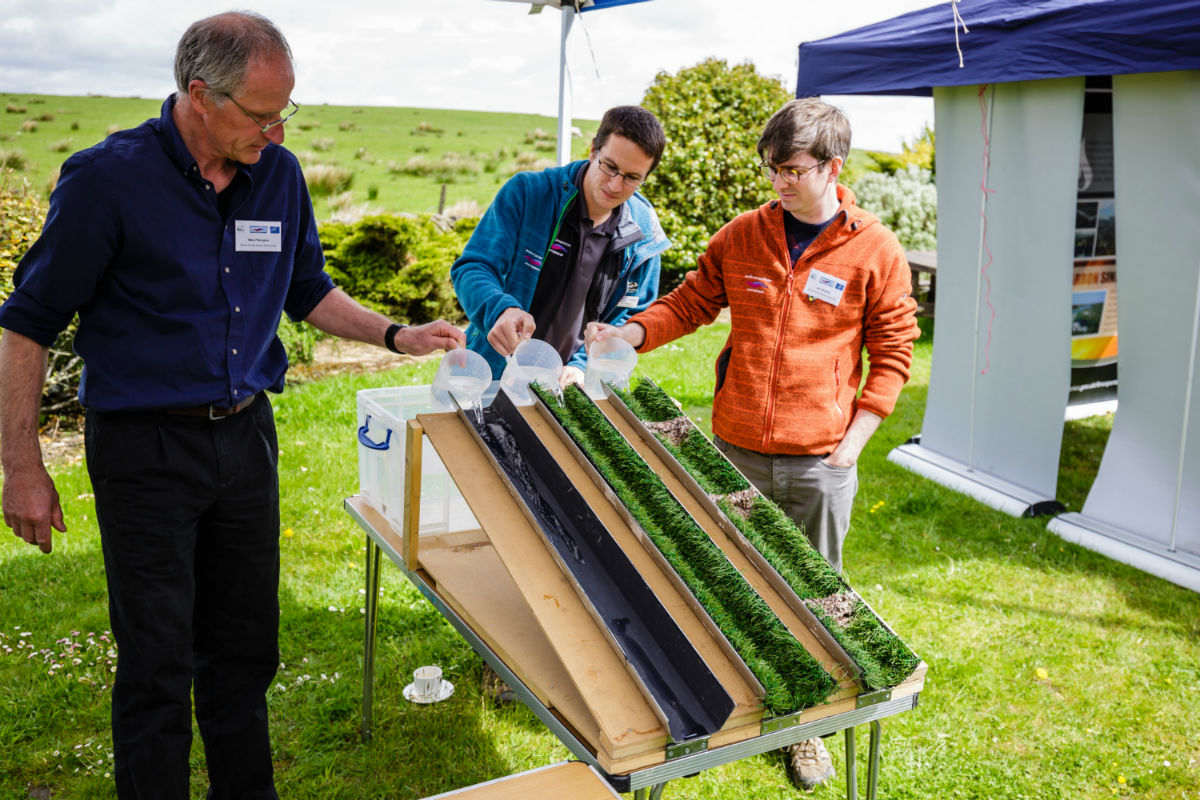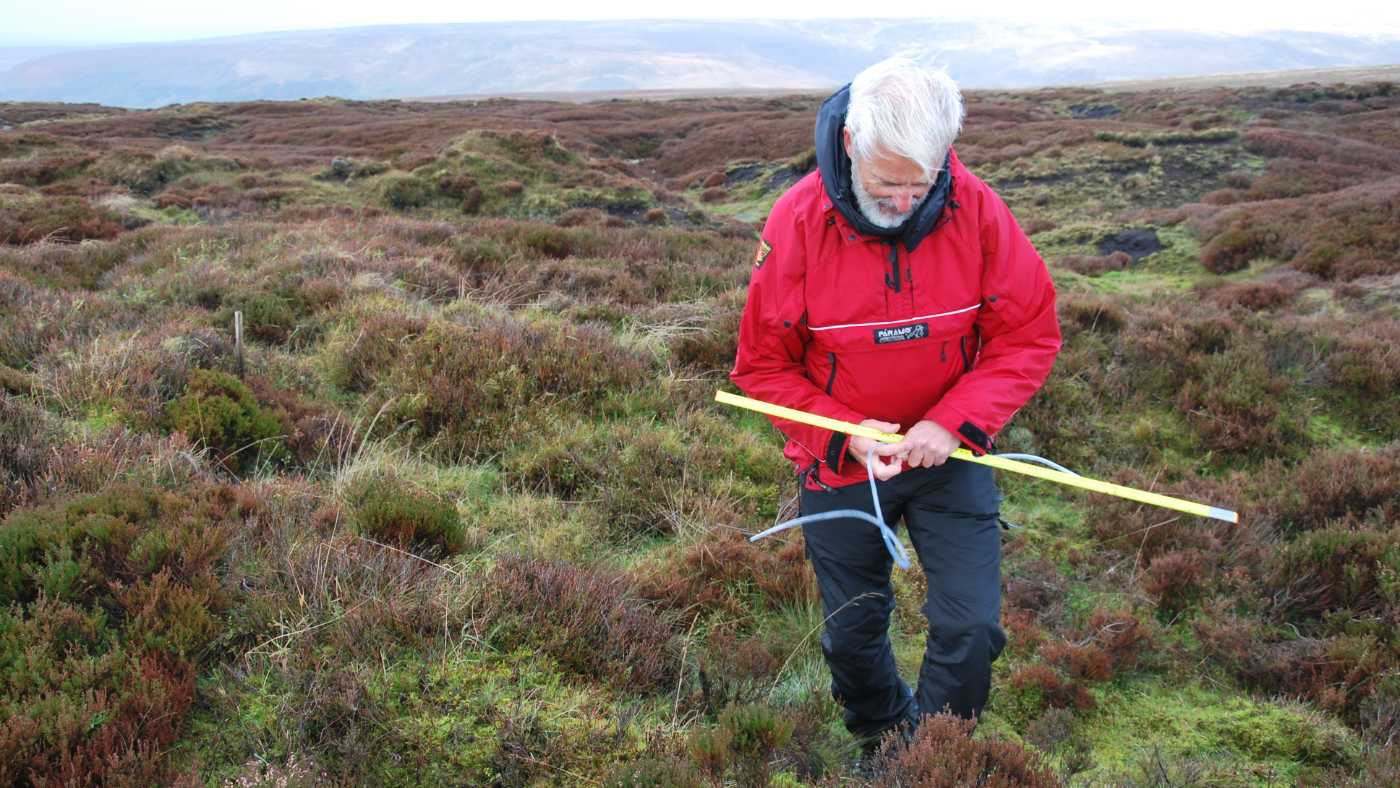
Meet our volunteers
Volunteering with Moors for the Future Partnership provides an opportunity for people of all ages, abilities and backgrounds to learn new skills, have fun, get closer to nature and make a real difference to the future our iconic upland moorlands.
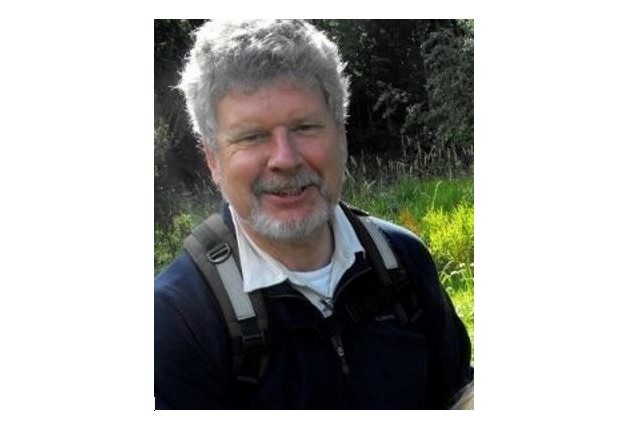
Nothing is inevitable: A chat with volunteer Giles Parsons
Giles Parsons worked in an office for 40 years. When he retired, he decided to try some radically different activities.
Giles' story
“I’ve volunteered for Moors for the Future Partnership (MFFP) for two years where I’ve been involved with the dipwell campaign, water quality monitoring, vegetation monitoring, and Bogtastic Van engagement. I also volunteer for the High Peak National Trust, as well as for a charity providing tax advice for older people, and I volunteer with the police. Oh and I’m a trustee for a canal museum. I like to keep busy, I get bored quite easily!”
Giles certainly has a lot on. But there are more to Giles’ volunteering activities beyond keeping boredom at bay.
“When it comes to volunteering with MFFP and the National Trust, it gets me into the great outdoors. But it’s more about wanting to be involved in making a positive difference. At 18 years old I walked the Pennine Way with my brother and I can remember it being this completely black landscape. And I thought that was how it was supposed to look.
“But now coming back to the landscape there is such a huge difference. Seeing the changes that have been made, and seeing that the landscape can be restored and protected in a relatively short space of time made me realise that environmental degradation isn’t inevitable.”
As someone who hasn’t spent a great deal of time in the uplands since his university days, Giles knows the value of explaining the importance of uplands habitats to people.
“I had limited knowledge of blanket bog before I started volunteering. I didn’t know as much as I now think I should. That’s something I like about going out with the Bogtastic Van. It’s a great opportunity to engage with people and explain why blanket bogs are so important and how we can help to enhance and protect them. I also like doing the experiments with the kids; sometimes I find that to be the best part.
“When we do events with the Bogtastic Van, we have these photos of Black Hill that show it going from a completely black landscape comprised of nothing but bare peat, to this wonderfully green and rich place. I was so inspired by these photos and they reminded me that as people, we really can have a positive impact. Our impact doesn’t always have to be negative.”
Giles spends a lot of his time working to help people and nature. He speaks passionately about how his own changing understanding has influenced why he wants to make a positive impact.
“Conservation activities are sometimes so simple in a lot of ways. Plant some moss. Block a gully. But they can stop environmental degradation and give the landscape the help it needs to transform.
“I saw a mountain hare for the first time on Howden Moor a few weeks ago. Others might have seen hares there before. But for me, it shows that decline doesn’t have to be our future.”
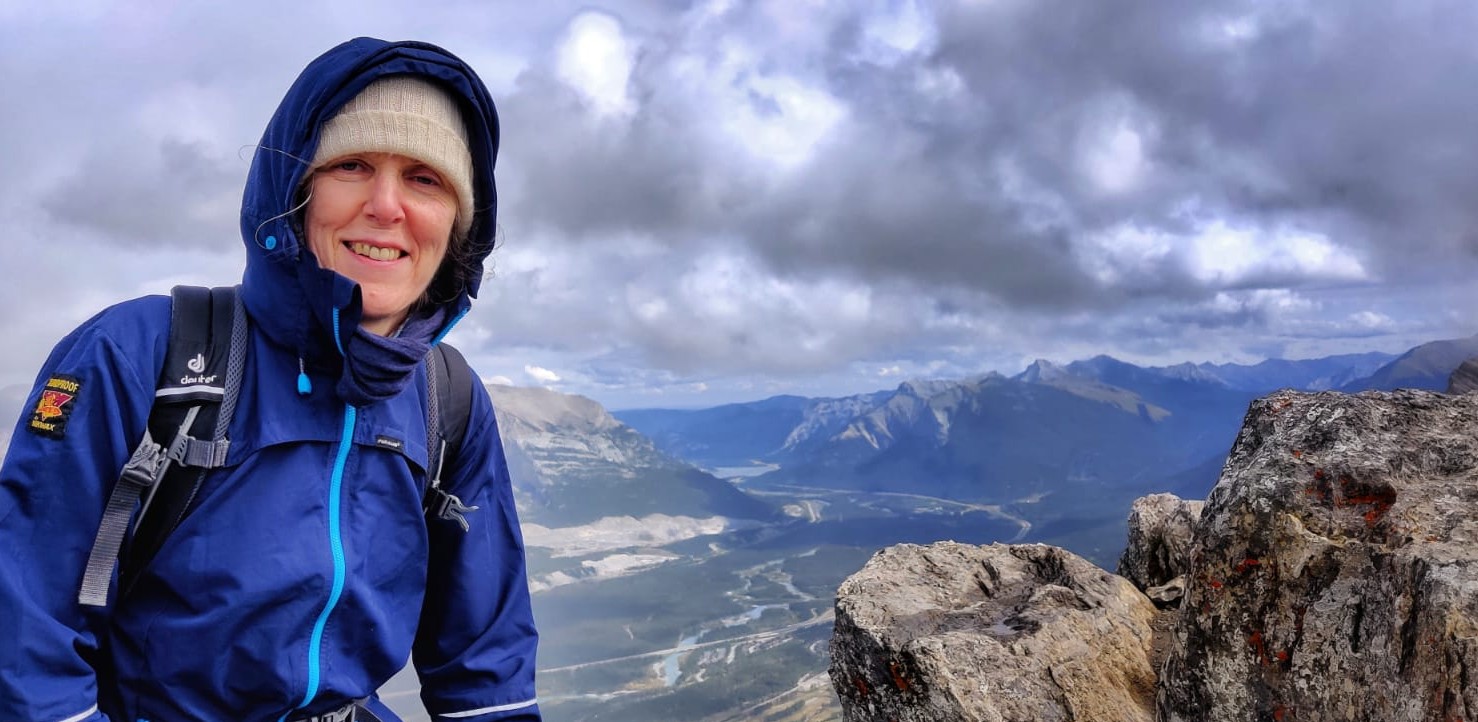
Moss education: A chat with volunteer Gill Hajduk
Gill Hajduk has been a volunteer with Moors for the Future Partnership for two years. Taking part in both summer and winter volunteering activities, Gill is certainly a member of the hardy volunteer club. We had a chat with her to find out more about what makes her keep coming back to the moors.
Gill's story
“I moved to Sheffield from Cambridge two years ago. After discovering the city, I started to explore the nearby countryside too. I knew the area fairly well because I used to be a keen rock climber and I’m still a fell runner and experienced walker. But to live on its doorstep is a whole different thing.
I have a background as a research biologist and a biology teacher and I have always had a generic interest in the natural world. So I looked into volunteering and found Moors for the Future Partnership. I did the volunteer induction 18 months ago and have been volunteering ever since with the summer vegetation monitoring and winter dipwell campaign.”
Gill’s background as a biologist has made her an avid learner:
“To be able to learn about the specific flora and fauna of the moorland has been quite special for me. I’ve always had some broad knowledge of the plants and animals that live up there, but never to this level of detail. I still have a lot to learn but I learn so much every time I go out with the other volunteers and Moors for the Future Partnership staff”.
Has this newly acquired knowledge changed the way she interacts with the moors?
“When I go on the moors now I look at the plants and animals and get excited when I see something in a certain place. For instance, when I spot some sphagnum moss, I give it a little nod of approval and think ‘yes that should be there’. I also love showing my friends the different species too. Sometimes I think I might be more excited than them though!
I love learning and the more I find out, the more I want to learn. Understanding the niches of the different species of sphagnum moss and how they co-exist with each other has been one of the most fascinating things I’m learning. And seeing the water table levels changing, sometimes weekly, during the dipwell campaign, and understanding what that means for the landscape makes me feel like I’m helping to make a difference.”
But it’s not just the famous sphagnum moss that has captivated Gill:
“I can’t believe how recently it was that so much of what should have been blanket bog was just bare peat. In this way, the history of the pollution and degradation doesn’t seem that long ago. It’s a story I knew nothing about, but now that I do I want everyone else to know it too.
The way I look at the moors has changed since learning more about them. Being able to recognise species and understanding their role in the ecosystem has enhanced my attachment to these wild places. It’s a very special feeling.”
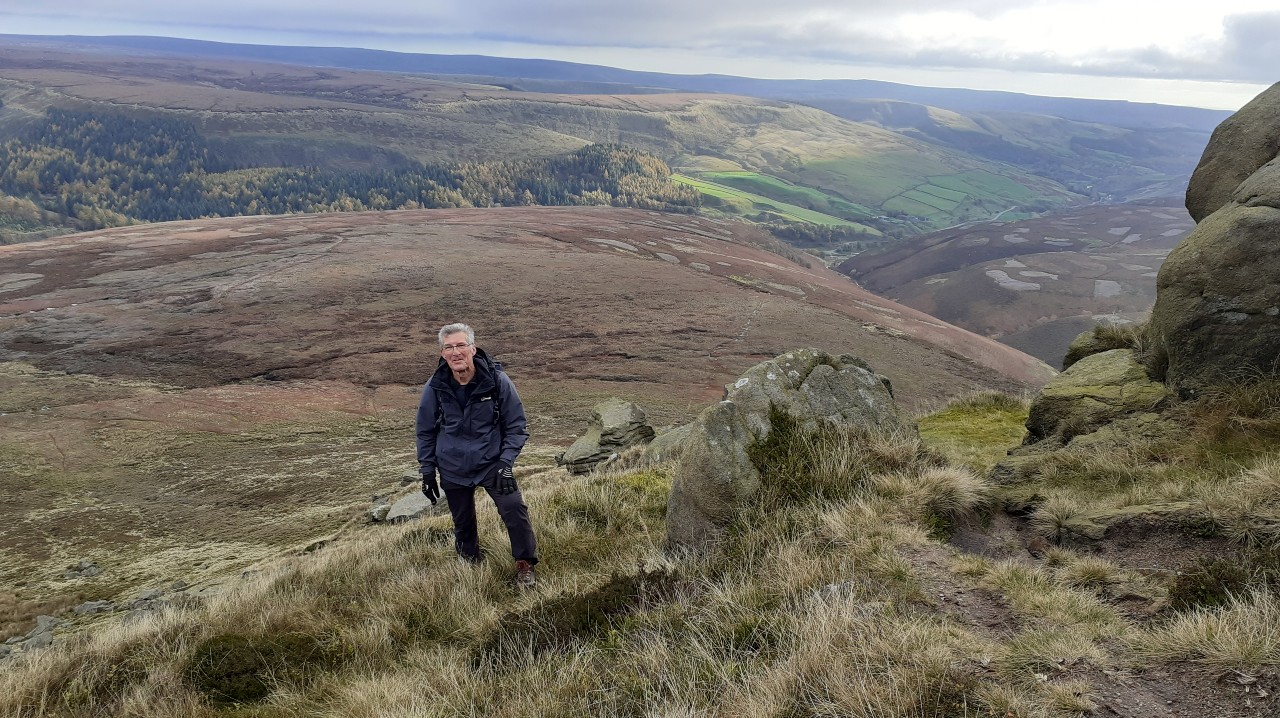
Regenerating nature, regenerating the self: dipwell volunteering with Paul Hatt
Paul Hatt has always used the great outdoors as a way to recharge his mind. Here he tells us more about what volunteering for nature means to him
Paul's story
Paul Hatt is a member of the famously intrepid Moors for the Future Partnership dipwell volunteer clan. These volunteers head out every week come rain, wind or snow, from September to December to collect valuable data on the water tables of the Peak District and South Pennine moors.
Paul has been volunteering with the Partnership for five years, since retiring. He has been involved in sphagnum data collection for the Community Science Project, plant identification for aerial photography and land mapping, and vegetation monitoring.
With an aptitude for learning, Paul has done several of the Partnership’s sphagnum and vegetation identification training sessions. But not content with always sitting in the classroom, Paul has been involved with the dipwell campaign for the last four years.
“My first experience of the dipwells was heading up onto Bleaklow on a snowy November day and clearing the snow from the dipwell tubes, then being taught what they were and how to take measurements from them”.
Living up to the hardy reputation, Paul wasn’t put off by the freezing winter weather.
“My wife says that the worst the weather, the more I seem to like it! It’s not strictly true but I think as long as I’m dry and warm and have plenty of provisions such as snacks, then what is there not to enjoy? Although there are always those times when you end up knee-deep in the boggiest bits or wading through a stream! We have had some very wild days on the moors, when sometimes I’ve wondered how we weren’t blown off the hill. But with the right kit, I don’t see the weather as a problem”.
Paul gets a lot of enjoyment from being on the moors even in the harshest weather with his volunteering. But this love affair with the great outdoors precedes his time with Moors for the Future Partnership.
“My wife and I were teachers of teenagers for 40 years and they can be a very challenging group to teach. Some weeks seemed to drain us so much. But we found that if we got out into the hills on the weekend, particularly into the wilder places, it would reset us so that we felt we could face anything in the week ahead. Some weeks it felt like being out in the hills was the only way to survive teaching (and raising!) teenagers. It re-established our core feelings so we could cope with anything. It made all the difference”.
The physical and mental benefits of spending time in nature have been keenly felt by Paul. His passion for the hills is striking and volunteering with Moors for the Future Partnership has expanded his opportunities to pursue this passion.
“Volunteering has shown me so many new places. I thought I knew Kinder and Bleaklow, for instance, but volunteering took me to different parts of them that I would never have known about otherwise, like Alport Castles. The work has given me this sort of gift of providing me with more places to go walking and to take photos”.
Photography is another passion of Paul’s, and he has been able to bring his volunteering work and photography hobby together.
“Of course my photos are not always very good because the weather can be so difficult! But I’ve developed quite a large stock of photos taken when I’ve been volunteering and I’ve been able to share them with the Castleton and Hope photography club and spread the word about what the Partnership does”.
Beyond his own enjoyment, Paul is determined to share the benefits he has gained from living a life filled with wild adventures.
“My grandchildren moved in with us during lockdown and we would take them into the surrounding hills to get some fresh air. Luckily we live in Castleton so the hills were close by. We noticed the changes in our grandchildren after spending some time outdoors. It seemed to reset them like it did us. I’ve realised that kids thrive on being outdoors. And I will be making sure that they carry a love of the outdoors with them always.”
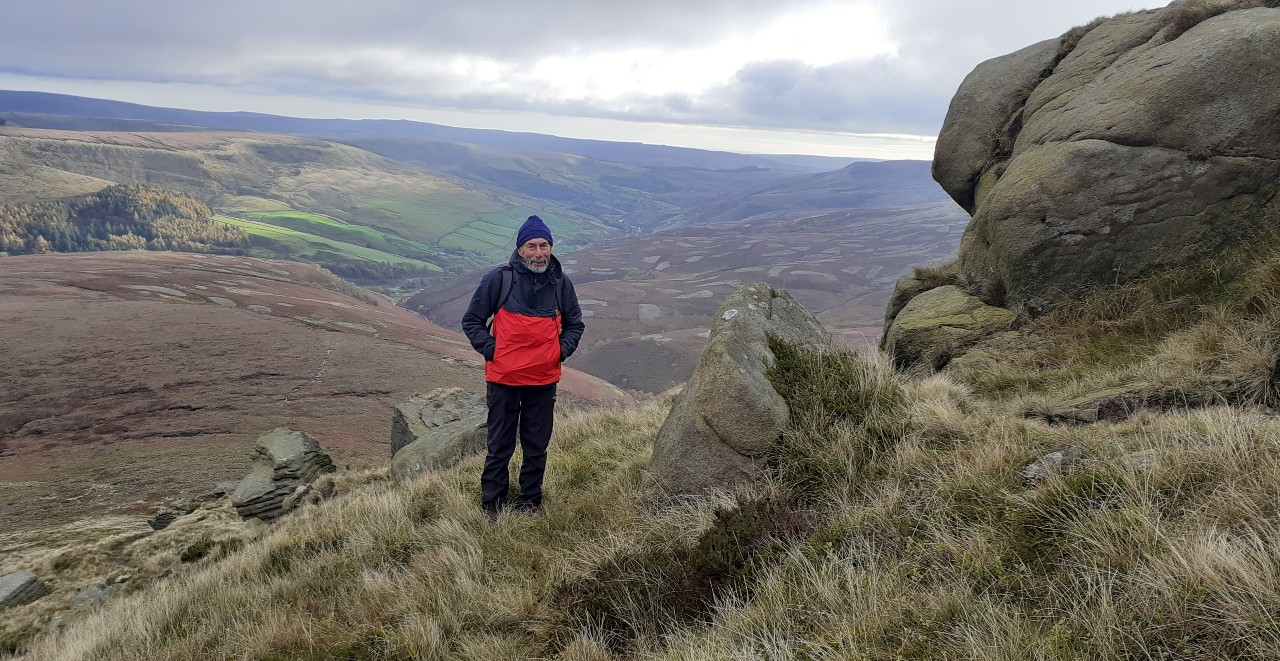
Bubbling, babbling and saving the world: a day of dipwell volunteering by Graham Berry
Graham Berry gives us an insight into an average day of collecting water table data.
Graham's story
9am: We meet at one of the small laybys near the Snake Inn, two volunteers and one of the Moors for the Future Partnership (MFFP) staff who will lead the party. Introductions and greetings completed, the most important topic then is the state of the weather and the forecast for the day. Have we got all the right gear? Judging by the size of the MFFP staff member’s rucksack, I certainly don’t seem to have. However, some off-loading reduces their size and increases ours, nevertheless it still seems like the staff have the short straw. Although, conveniently but not deliberately, I do have only a small rucksack!
9:30am: It is a relief to leave the layby and the passing intimidating traffic which on rainy days does prepare us for the tops by splashing us with puddle water. Fortunately, the waterproofs are already on! The view across the river Ashop to the mighty Kinder Scout plateau, even when it is blanketed by mist, lifts the heart and reminds us of why we keep coming back to support efforts to conserve this landscape. Breathless as we are, climbing directly from the wooden bridge up Nungrain on the northern side of the rightly named Fairbrook, we do manage to talk. The conversations are wide ranging, from some of the technicalities of the conservation work, i.e., is the water table rising, is the revegetation performing as expected, particularly the sphagnum moss, has the flood risk downstream been reduced … to, more generally, which boots or shoes are most suitable for this work, what are the favourite snacks for these moorland outings, our other mountain experiences … we do babble on! These conversations provide a welcome distraction from the hill walking slog through the peat and heather and up the final steep slope to Fairbrook Naze.
10am: Arguably, the Mushroom Stone there has one of the grandest and most panoramic views in the Dark Peak. Further on, our reward is a more level walk along the precipitous northern edge of Kinder with more expansive views over Bleaklow, Black Hill, Manchester and beyond (at least on a clear day!).
10:30am: Too much spectacle, we need to get to work! The MFFP GPS is brought out to lead us across the moor to the first of our sets of measurement locations. Nominally Kinder is flat, varying in height by about 40m from most of the edge to the highest point. It is misleading to describe this place as a point as, disappointingly, there are few if any “points” or peaks on the Kinder plateau! However, look at any map of Kinder and you will find it is laced with streams and these flow in groughs which can be three or four metres deep, not, definitely not, flat. Depending on our direction of travel, we can either go along the stream bed (wet feet) or cross the groughs (hard work). When we are near the targeted area, it is always surprising what a welcome sight the white tube marking the centre of the site is.
11am: Here, our equipment is unloaded; a folding metre ruler with an attached flexible plastic tube, a dipwell location map, a pencil and a notepad and more layers to wear. Rucksacks are left at the centre of the site, providing an important “landmark”, (details of this “landmark” later). A dipwell consists of a plastic tube (approximately 25mm diameter) which has been inserted in the ground and identified by a number – usually 1 to 15. On the northern-edge area there are three general subdivided sites named Nogson, Olaf and Firmin. Firstly, the height of the tube above the ground is measured and then the rule with the attached tube is inserted into the dipwell. Now, here’s the sophisticated bit. The flexible plastic tube is blown down until bubbles can be heard and the depth from the top of the dipwell is recorded. The water table depth can then be calculated. In total, there are about 200 measurements to record. A key part of the exercise is to find, in this jumbled landscape, each dipwell which is usually marked by a cane which uncannily looks like some of the surrounding vegetation (willow herb?). This search can be quite disorienting especially when distant landmarks (e.g. Manchester) are not visible; hence the importance of the pile of rucksacks, hopefully still visible, at each centre. It seems to be a rule that the last dipwell on each site is always difficult to find and accordingly very satisfying when it is found.
2:30pm (hopefully): There may be time, at some stage, to have a quick tea or coffee and a bite to eat before returning.
3pm: Having completed the measurements, there is a feeling of real satisfaction. We can now return, via the same route, and there’s usually a chance to warm up through some exercise and through the shelter from the prevailing westerly wind. It’s been another grand day out in good company knowing we have contributed a little to an essential project which might contribute to saving the world. Who would have thought that blowing down a plastic tube could be so significant!
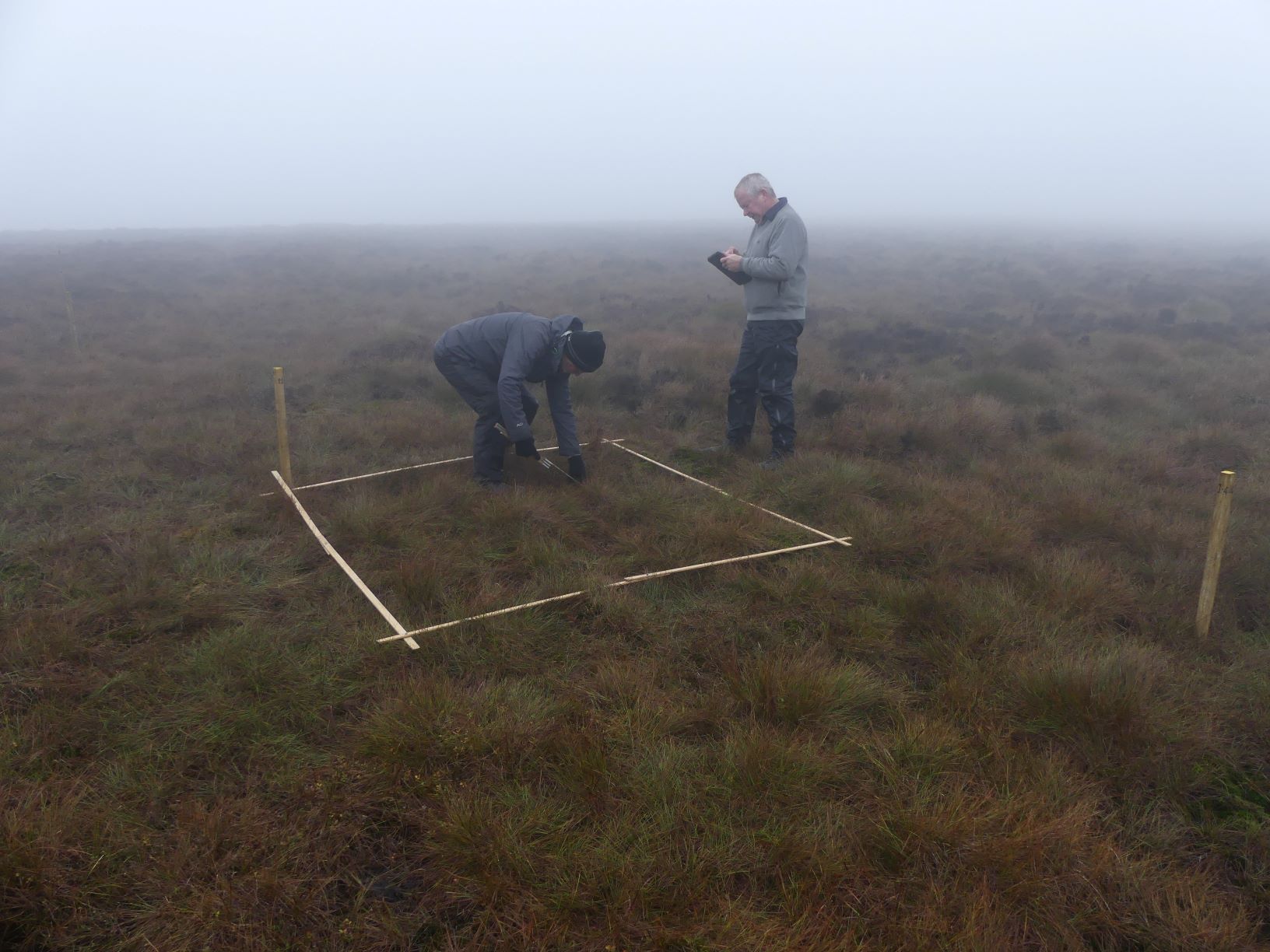
A brand new adventure: a chat with volunteer Tom Helliwell
Tom Helliwell had worked behind a desk his entire life. When he was made redundant, he took it as an opportunity to do something radically different.
Tom's story
“I used to go camping in Edale when I was a little lad, but once I’d grown up and life got busier and busier, visiting the Peaks became just a distant memory. But when I was made redundant, I started spending time again on the moors. I didn’t know it at the time, but I was looking for inspiration of what to do with myself now I had the time.”
Tom found out about volunteering for Moors for the Future Partnership when looking for walking routes on the Peak District National Park’s website.
“Being a volunteer on these massive, open moors was something completely different to working in an office. It’s an entirely new experience and I was a little nervous because my knowledge of blanket bogs felt limited. I also wasn’t a very active person beforehand but years of volunteering have really improved my fitness. On my first say out in September 2014 we walked from the Snake up onto Kinder to measure the water flow in some of the gullies. The worry I’d had of not being good enough melted away. The staff were supportive and the view was sensational. I was hooked”.
Volunteering on science and conservation projects has helped improve Tom’s knowledge of plant and animals species.
“The staff I work with really know their stuff, so I’ve been able to act a bit like sphagnum and soak up all their knowledge. I still struggle sometimes with the different species of sphagnum, but with help from colleagues and the handy field guides I'm improving. I'm much better with the different grasses and other plant species though!”
Most recently, Tom has been involved with setting up the cotton grass cutting trials. These trials are investigating whether cutting cotton grass helps sphagnum moss to grow. Tom is also currently involved in his fourth annual dipwell campaign.
“I like being involved in a range of projects. It keeps me busy, as it means I’m always learning something new, which is important to me. I’m one of those people that always wants to be learning new skills and finding out new information. There’s so much to discover about the natural world. If I learn something new, it’s been a good day”.
The moors are notorious for their wet, misty, and cold weather and it is always interesting to find out how volunteers cope with this harsh environment.
“I don’t mind the weather when you’re dressed for it. I was out with someone, on one of those wet, misty and cold days, who forgot the GPS so we didn't manage to locate all the sites we were supposed to. It ended up being a longer day than planned and we were pretty wet and miserable by the end of it. When I get home I like to unwind with a cup of tea and a few biscuits by the fire, I certainly needed it that day!
Tom regularly volunteers and this summer has been a busy one for him. At very busy times he volunteers between 1 to 3 days a week.
Tom why do you keep coming back?
“The moors round here inspired me to do something completely new. I do things I’d never even thought about doing before which has been invaluable to me. But more importantly, on one of the sites I regularly work on, there is a butty van on the road where we park. Having a bacon butty before lugging all that equipment across the moors definitely helps to keep me motivated. Although the last few times I’ve been the van hasn’t been there…perhaps I should ask to work on another site, preferably the one where the van has gone!”
Volunteers are invaluable to Moors for the Future Partnership. Thank you to Tom and all our volunteers for your continued dedication and enthusiasm. We would be lost without you!
Jane's story
Jane Price, who lives in the Peak District, volunteered for our Community Science Project.
Wanting to work in conservation she took early retirement from the NHS. “Volunteering is a brilliant way to get experience and to find out if conservation is for you.”
Learning new skills, taking part in science and getting satisfaction from taking part and knowing that your work is contributing valuable information about the moorland habitat are among the benefits.
"It is something that gives you a buzz," said Jane who has been involved in surveying specific types of bumblebees. She learned to identify different types of bees and improved her observation skills, and enjoyed working together in a team.
By getting close to nature, and learning how to observe and identify the different species Jane has noticed that it has changed the way she sees the moors.
"It has helped me see the moors in a different way and be much more observant about my surroundings."
Data collected and recorded on the national irecord website is shared with conservation organisations at local, regional and national levels.
For Jane meeting new people has been one of the highlights of volunteering. It has also helped her gain valuable experience that led to her taking a casual research and monitoring post, which then led to her getting a part time job with the Partnership as a conservation works officer.
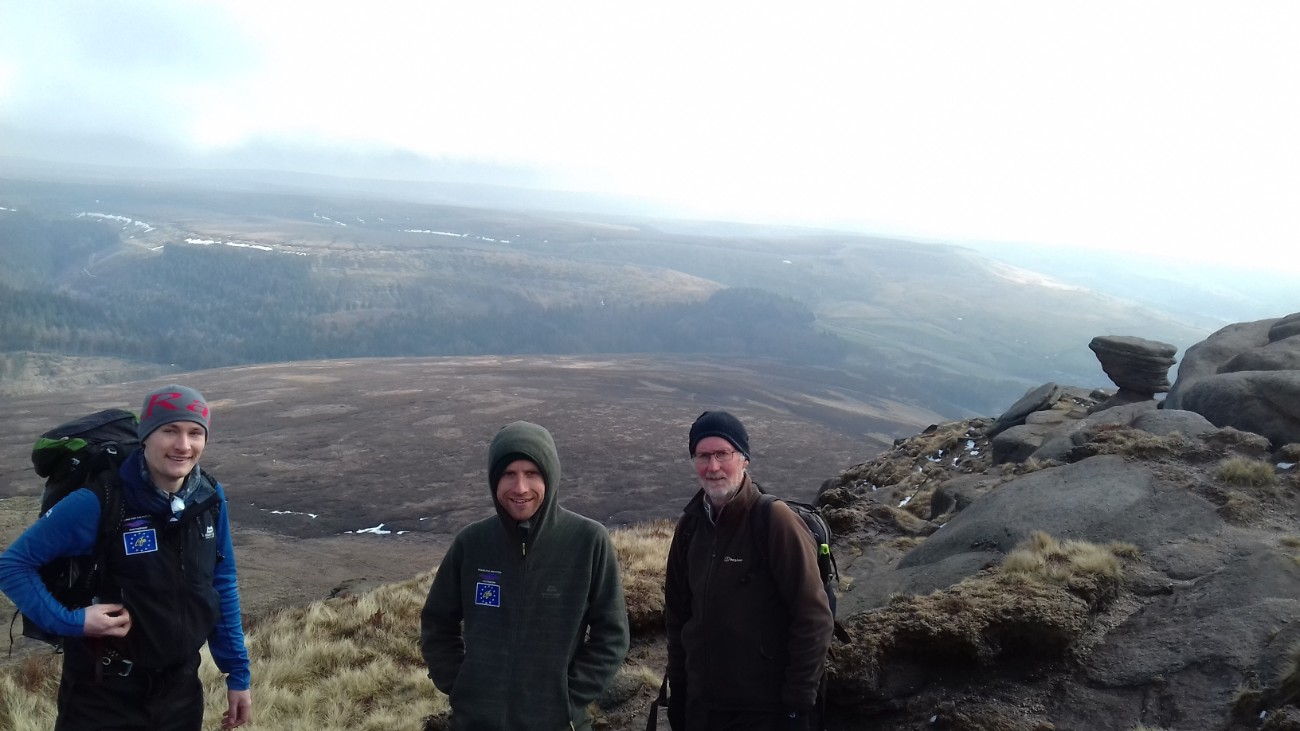
Meet our volunteers – Tony
Tony came to us as a volunteer eight years ago. After volunteering for four years, he applied for a job where he has since been involved with around 20 different projects.
Tony's story
“I love the South Pennines and Peak District moors. Even on the coldest, wettest days when the wind is howling, they are still magic places. The moors want you to know who’s in charge and it’s always them” says Tony Rogers, a Moors for the Future Partnership research and monitoring officer.
“I’ve been on these moors in everything from a thin t-shirt to 6 layers and I’ve enjoyed every moment! In fact, the wilder weather days can be some of the most memorable if you go properly prepared”.
“It’s really special to have been part of some of the conservation projects from the beginning and to witness their progress over the years. It really gives me a sense of attachment to these moors as we work to bring them back to health”.
Tony has been involved with the Kinder Edge sphagnum moss planting project since 2015, and this one has been a particular favourite. This project experimented with the different ‘forms’ that sphagnum moss can be applied in. Because of the lack of sphagnum local to Kinder, the sphagnum has to be grown or ‘propagated’.
However, propagated sphagnum doesn’t always come in mossy plant form. It can come in bead form (that look like peas) where each bead can have several different types of sphagnum moss in it. Sphagnum can even come in slime form!
“It is cutting edge research looking into which forms of sphagnum will grow better where. Being part of such change-driving research is amazing and I get excited by each new set of results that come in”.
Tony carries out the research as part of a team of staff and volunteers.
“The staff are really knowledgeable and I’ve learnt a lot working with them over the years; the enthusiasm of the volunteers is inspiring. They don’t have to do this, but they do and they love it and that keeps you smiling”.
Sometimes Tony isn’t in a group and ventures out onto the moors alone (with a dedicated buddy checking on his safety!). With no teammates to keep his morale up during bleak weather or long hikes he has to keep up his own spirits. But that’s not a difficult task for Tony.
“I never feel alone on the moors because there’s always something happening! There’s so much to see, hear and feel. Birds to listen to, mountain hares to watch, and occasional bilberries to taste. You might be separated from humanity, but you’re in the midst of countless wildlife communities. Although, sometimes I do wonder how I’m going to get my fingers to work when the wind chill is particularly severe!”
Tony has been hill walking all his life, but working for the Partnership has allowed him to experience the moors in a different way.
“It’s a real privilege to get to the wilder places away from the footpaths that people rarely have the opportunity to see, and to be there with a purpose, helping to return this special landscape to its former glory”.
When considering his life plans, Tony sometimes wonders when he’ll retire.
“This job is way too good for my mind and fitness to think about retirement yet. I guess it will happen one day but I don’t see retirement on the horizon any time soon, even from the top of Kinder!”
